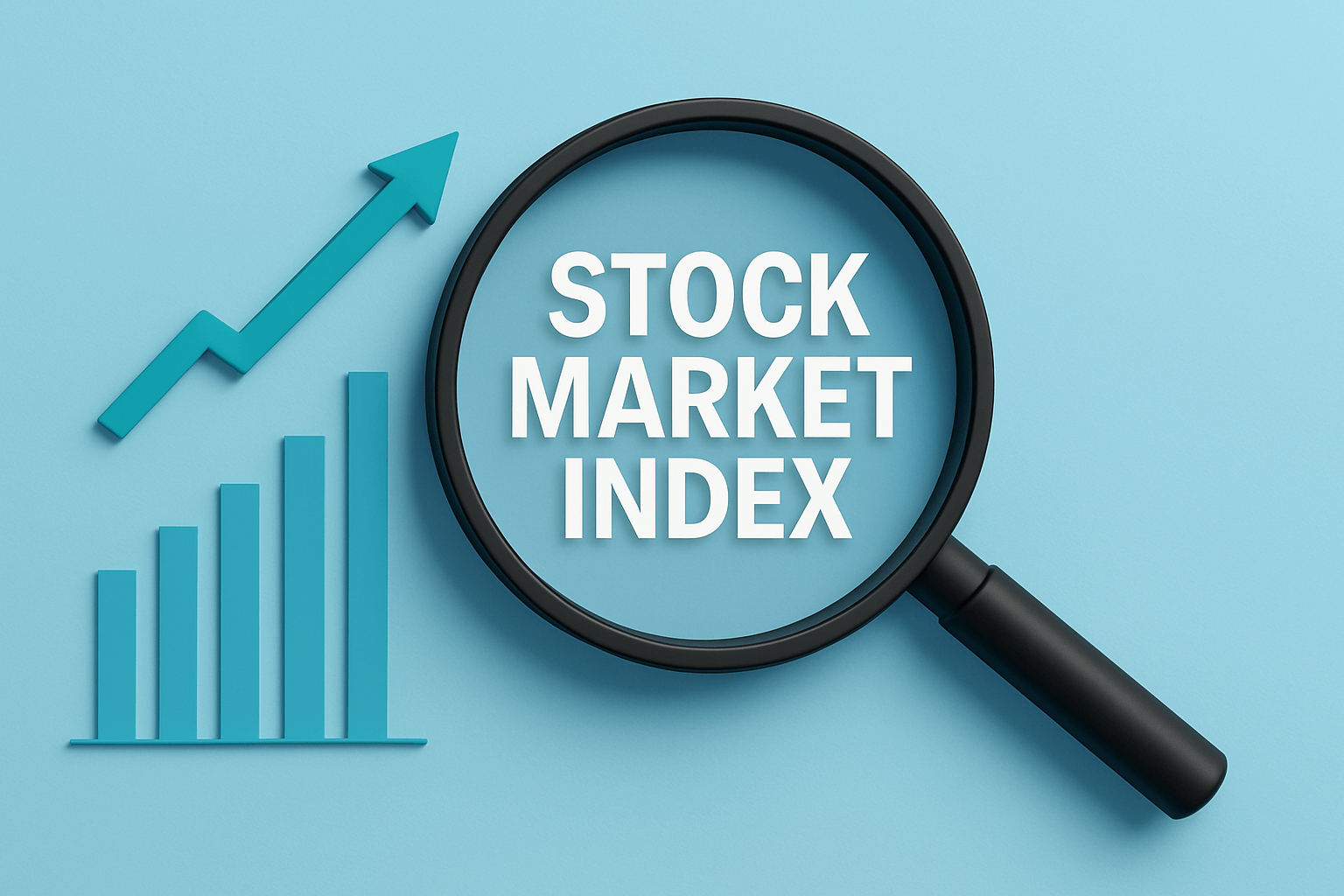What Is The Index In The Stock Market?

- Published Date: November 13, 2025
- Updated Date: November 17, 2025
- By Team Choice
The stock market index serves as a reflection of market performance, enabling investors to determine whether the market or a specific sector is trending upward, downward, or remaining stable.
It serves as a benchmark that reflects how a selected group of stocks is performing on exchanges like NSE and BSE. If you want to understand what is the index in the stock market and why it’s so important, this guide covers everything you need to know. We’ll explore how indices are formed, their different types, why they matter, and how you can use them.
What Is Index In Stock Market
First, let’s understand what define stock market indices in the stock market:
A stock market index is a statistical indicator that measures the overall performance and price movement of a group of selected stocks within a market. Simply put, it reflects how a particular segment or the entire stock market is performing over time.
An index is created by selecting shares from companies that share common characteristics, such as belonging to the same sector, having similar market capitalisation, or meeting specific listing criteria on an exchange. These chosen stocks are already traded on major exchanges like the NSE and BSE, and together they form the base of the index.
Each stock market index tracks how these selected stocks perform. When the prices of the underlying stocks increase, the index value rises, and when they fall, the index value drops. This makes it a reliable benchmark to understand market trends and investor sentiment.
In essence, an index acts as a performance indicator for the share market, helping investors quickly grasp whether the market is bullish, bearish, or stable.
Types of Stock Market Indices
There are different types of stock market indices designed to track various aspects of the financial market.
1. Sectoral Indices:
Sectoral indices measure the performance of companies operating within a specific industry. Both the NSE and BSE have sector-based indices that help investors analyse how a particular sector is performing compared to the broader market.
For instance, Bank Nifty tracks the performance of leading banking stocks, while indices like S&P BSE Healthcare and Nifty Pharma reflect trends within the pharmaceutical sector. These indices are valuable tools for investors who want focused exposure to a particular segment of the market.
2. Benchmark Indices:
Benchmark indices are the most widely followed indicators in the Indian stock market. They represent the performance of the largest and most liquid companies listed on the exchanges.
The Nifty 50 on the NSE and the Sensex on the BSE are classic examples. Nifty 50 tracks the top 50 companies across major sectors, while Sensex includes 30 of the most prominent companies on the Bombay Stock Exchange. Because they set the standard for market performance, these benchmark indices are often used by investors and fund managers to compare returns and determine overall market sentiment.
3. Market Capitalisation Indices:
Some indices are formed based on the market capitalisation of companies, essentially their total market value. These are categorised as large-cap, mid-cap, and small-cap indices.
Examples include Nifty Midcap 150, Nifty Smallcap 50, and S&P BSE Smallcap. These indices help investors choose companies that align with their risk tolerance and investment goals. For example, small-cap indices tend to be more volatile but offer higher growth potential, whereas large-cap indices are generally more stable.
4. Other Types of Indices:
Beyond sectoral, benchmark, and market cap categories, several broader and thematic indices represent specific investment themes or strategies.
Indices like Nifty 100, S&P BSE 500, and S&P BSE 100 cover a wider range of companies and provide a more comprehensive picture of market performance. Similarly, thematic indices such as Nifty ESG or Nifty Infrastructure focus on specific ideas like sustainability or infrastructure development.
How is an Index Formed?
The formation of a stock market index follows a systematic process designed to represent a specific segment of the market accurately. Here’s how an index is typically created:
1. Selection of Stocks: An index is formed by selecting a group of stocks that meet specific criteria. These may include market capitalisation, liquidity, trading frequency, and sector representation.
2. Weightage Assignment: Each stock in the index is given a weightage based on its market capitalisation or free-float market value. This means larger companies have a greater influence on the index movement compared to smaller ones.
3. Base Year and Base Value: Every stock market index starts with a base year and base value, which serve as reference points. Changes in stock prices are compared against this base to calculate how much the index has risen or fallen over time.
4. Regular Review and Rebalancing: Indices are reviewed periodically to ensure they continue to represent the market accurately. Companies may be added or removed based on updated performance, liquidity, or compliance with eligibility criteria.
5. Calculation of Index Value: The index value is calculated using a free-float market-cap weighting. In simple terms, when the prices of constituent stocks rise, the index goes up; when they fall, the index value drops, making it a true reflection of market trends.
Why Are Stock Market Indices Important?
Here are some of the main reasons why stock market indexes are important for investors, traders, analysts, and even policymakers:
1. Measure Overall Market Performance:
A stock market index acts as a benchmark to evaluate how the overall market is performing. For example, when the Nifty 50 or Sensex moves upward, it indicates a positive market trend. Similarly, a decline in these indices reflects a bearish or weak sentiment in the market.
2. Serve as a Benchmark for Investments:
Investors often use indices as performance benchmarks to assess their own portfolios. For instance, if your investment in stocks or mutual funds performs better than the Nifty 100 or Bank Nifty, it suggests that your portfolio has outperformed the market average.
3. Simplify Market Analysis:
Tracking thousands of individual stocks is nearly impossible. Indices simplify this by grouping selected stocks that represent the market or a particular sector. This makes it easier for investors to quickly understand how certain areas of the economy, such as IT, banking, or pharma, are performing.
4. Support Derivatives Trading:
Many futures & options contracts are based on major indices like Nifty 50 and Bank Nifty. These instruments allow traders to hedge risks, speculate on market movements, and manage their portfolios more efficiently.
5. Reflect Economic Health:
A rising index usually indicates a growing economy, higher investor confidence, and strong corporate performance. On the other hand, a falling index may signal economic slowdown or declining investor sentiment. In this way, indices act as economic indicators for policymakers and analysts.
6. Help in Passive Investing:
With the rise of index funds and ETFs, indices have become essential for passive investors. These funds replicate the performance of popular indices, offering diversification, lower costs, and steady returns over the long term.
How To Use Stock Market Indices In Your Investment Strategy?
Here’s how investors can effectively use stock market indices in their investment approach:
1. Benchmark Your Portfolio Performance:
Indices like Nifty 50 and Sensex act as benchmarks to measure how your portfolio is performing. If your returns are higher than the index, you’re outperforming the market — if not, it may be time to review your strategy.
2. Track Market and Sector Trends:
Indices help investors analyse market direction and sector health. For instance, a steady rise in Bank Nifty shows strength in the banking sector, while a dip in Nifty IT may signal weakness in tech stocks.
3. Invest Through Index Funds or ETFs:
For a simple and long-term approach, invest in index funds or ETFs that replicate indices like Nifty 100, Nifty 50, or Sensex. These funds offer broad diversification, lower risk, and steady growth without the need for active stock-picking.
4. Diversify Using Sectoral Indices:
Use sector-based indices such as Nifty Pharma, Bank Nifty, or Nifty FMCG to diversify your investments. Spreading your money across different industries helps manage risk and balance returns.
5. Trade Using Futures & Options:
For active traders, indices form the base for futures & options contracts. Instruments like Nifty 50 or Bank Nifty derivatives allow you to hedge existing positions or profit from short-term price movements.
6. Monitor Volatility and Sentiment:
Keep an eye on the volatility index in the Indian stock market (India VIX) to assess investor sentiment. Rising volatility indicates uncertainty, while lower volatility often signals market stability.
Some Well-known Indian Indices
| Index Name | Exchange | No. of Stocks | Description |
|---|---|---|---|
| Nifty 50 | NSE | 50 | Tracks 50 large-cap (top) companies from various sectors. It is the benchmark index of the National Stock Exchange. |
| Sensex | BSE | 30 | Represents the top 30 large-cap, financially sound companies listed on the Bombay Stock Exchange (BSE). It is the benchmark index of the BSE. |
| Nifty 100 | NSE | 100 | Represents the top 100 companies by market capitalisation. It is mathematically the combination of the Nifty 50 and the Nifty Next 50. |
| Bank Nifty | NSE | 12 | It includes the leading banks in India. It is a key sectoral index reflecting the performance of the financial/banking sector. |
Conclusion
Understanding what index is in the stock market is essential for every investor or trader. Indices simplify complex data, track performance, and help guide investment strategies. Whether you invest in Nifty 50, Bank Nifty, or Nifty 100, these benchmarks provide valuable insights into the market’s pulse.
Start by learning about key indices, tracking their performance, and building your strategy around them. And if you’re ready to participate, open a Demat account with Choice to begin investing in India’s growing equity markets.
FAQs
1. What is the meaning of index in the stock market?
An index in the stock market represents a group of selected stocks that show the overall performance of a segment or the entire market.
2. What are index futures in the stock market?
Index futures are derivative contracts that allow traders to speculate on or hedge against the future value of a stock market index.
3. How to trade indices in the Indian market?
You can trade indices through futures & options on platforms like NSE. To get started, you’ll need to open a Demat and trading account.
4. Are indices the same as stocks?
No. Stocks represent ownership in a single company, while indices represent a collection of multiple stocks.
5. How many indices are in the Indian stock market?
There are dozens of indices, including broad market ones like Nifty 50, Nifty 100, and sectoral indices like Bank Nifty, Nifty IT, etc.
6. How to trade indices for beginners?
Beginners can start by learning how index funds work or practice trading index futures using virtual trading platforms before investing real money.
Disclaimer: “Market investments are subject to risk. Past performance of indices does not guarantee future results. Derivatives are complex and may not suit all investors.”
Recommended for you

FII DII Data - Live Data

Share Market Prediction For Tomorrow

Market Prediction Today (23th December 2025)
